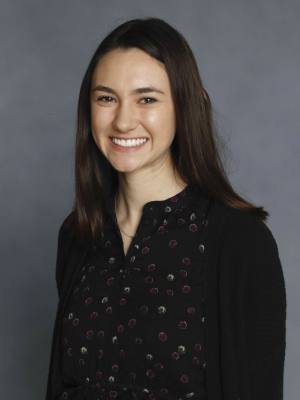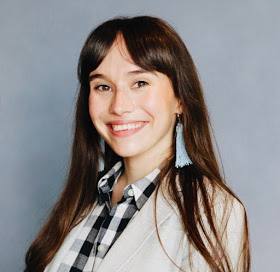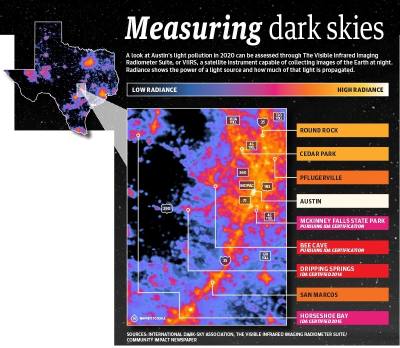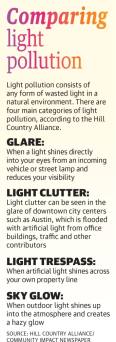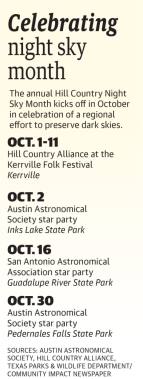With the authorization of a recent state bill, Senate Bill 1090, cities across Texas can again apply for a designation of a Dark Sky Community from the International Dark-Sky Association. In order to attain that title, a town must enact certain restrictive lighting regulations on residential, municipal and commercial properties—something cities were unintentionally barred from doing through a 2019 bill.
“I’ve heard a number of advocates say they can now get started. [The application process] takes a while,” said Cindy Luongo Cassidy, the IDA Texas chapter director. “Some communities have started already and are hoping to get going quickly.”
SB 1090 now opens the door for communities to again apply for Dark Sky Community status. Local advocates say that designation, as inconsequential as it may seem, has the potential to draw stargazing enthusiasts from across the globe who flock to remote areas in search of the increasingly elusive dark sky.
A 2016 study published in Science Advances found 99% of U.S. and European populations live in places with “light-polluted skies.” The research team further found the Milky Way—the galaxy that includes Earth’s solar system—can no longer be seen by nearly 80% of North Americans due to light pollution.
“The Hill Country, we know, is becoming a hotspot for astro-tourism, and the reason that people move to the Hill Country is because they want that natural connection, and part of that is the night sky,” said Dawn Davies, the Night Sky program coordinator at Hill Country Alliance.
LIGHTING REGULATIONS
Under the IDA’s designation, there are already several existing International Dark Sky Places dotted throughout the state. In all, 15 sites are designated as Dark Sky Places in Texas, and seven of those are located between Fredericksburg and Austin.
Dripping Springs became the first Dark Sky Community in 2014, meaning the city adopted outdoor lighting ordinances to preserve the quality of the night sky, according to the IDA website. Horseshoe Bay followed not long after, becoming a certified IDA community in 2015.
Most recently, McKinney Falls State Park in southeast Austin applied for an Urban Night Sky Place designation, Davies said, and the expectation is the state park will receive the title. These areas are sites near urban centers that “actively promote an authentic nighttime experience in the midst of significant artificial light,” according to the IDA website.
A site such as McKinney Falls State Park is only now able to apply for IDA status because of provisions outlined in SB 1090. The bill establishes standards for materials used in development—such as light structures and sconces.
“In 2019 there was action taken by the Legislature to ensure that cities and other governmental entities wouldn’t be in the business of picking winners and losers in the market for products used in constructing homes. It didn’t have legislation that permitted future Dark Sky communities to be established,” said Rep. Andrew Murr, R-Kerrville, who sponsored the 2021 bill. “[SB 1090] picks up where that left off as an unintended consequence.”
The new bill now allows communities to enact lighting ordinances and standards that meet the IDA’s requirements to become a Dark Sky Community. Any restrictions on building materials that go past the necessary measures for IDA designation are prohibited by SB 1090.
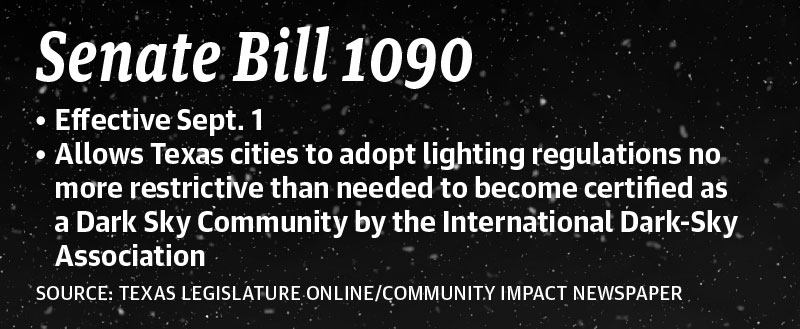
In 2011, the IDA approved its model lighting ordinance, or MLO, to serve as a template for municipalities to develop more responsible lighting standards. Under the MLO, outdoor lighting fixtures such as street lamps must be designed with proper shielding to reduce glare and prevent light trespass, which occurs when artificial light extends past a property line. Other requirements include an 11 p.m. lights-out curfew for nonresidential properties as well as standards for lighting color and temperature. Generally, the IDA recommends a warm-toned amber light with a temperature under 2700 Kelvins.
Similar dark sky standards are upheld by the city of Bee Cave, which has been pursuing IDA dark sky designation for at least a year, said Megan Will, planning and development director for the city. By the end of 2021, city staff will unveil updated lighting ordinances in full compliance with IDA standards, but Will said protecting the night sky has been a priority for the city and its residents since at least 2007.
A couple of neighborhoods in South Austin were given IDA designations as Dark Sky Friendly Developments of Distinction for enacting planning that “promotes a more natural night sky,” according to the IDA.
That program was ended by the IDA in 2020, however. Luongo Cassidy said that in lieu of pursuing that designation, interested property owners in master-planned communities or HOAs can now apply for IDA Texas’ Be a Star Award. The designation has already been awarded to people in 15 separate Texas counties.
“That is a designation on a specific property. ... It is only tied to the type of lighting you control on the property you own,” Luongo Cassidy said.
DARK SKY TOURISM
Dark sky proponents say designated sites can attract a niche visitor to the Hill Country—astro-tourists.
These tourists come from around the U.S.—and sometimes from around the world—to catch astronomical events in areas with a preserved night sky.
In 2019, two researchers from Missouri State University estimated astro-tourists have the potential to generate billions of economic impact dollars in the Colorado Plateau, a region that encompasses parts of Utah, New Mexico, Colorado and Nevada. The study states nonlocal tourists from the area “who value dark skies” will spend $5.8 billion in the area over the next decade, generating $2.4 billion in higher wages for workers.
“There’s a lot more tourism in state parks and more demand for programs in the parks that have Dark Sky designations,” Luongo Cassidy said. As it so happens, a major astronomical event will cross through Central Texas in 2024 that may draw in international visitors.
A total solar eclipse will cross through North America on April 8, 2024, similar to the astronomical event that occurred Aug. 21, 2017, according to the American Astronomical Society. The path of totality, where it is possible to observe the phenomenon of total eclipse, will run straight through the Hill Country, cutting just west of Austin on a path north to Montreal.
Luongo Cassidy anticipates tourists will flock from all corners of the Earth to observe the total solar eclipse around Austin. And when they come, Luongo Cassidy said, they will be searching for Dark Sky communities where the eclipse will not be interrupted by artificial light.
“Those people want to find a place where they can have a reasonable place to stay and where there won’t be nasty lights that come on during the eclipse,” Luongo Cassidy said. “A lot of the people who come for the eclipse will stay for the whole week. You talk about good tourism dollars—I imagine it will be quite busy around here.”
DEVELOPMENT CONCERNS
While the Texas Hill Country region has become a hot spot for astro-tourism, it has also been the site of emerging developments and population growth.
The increase in large master-planned communities is a real concern for dark sky advocates such as Davies. As the night sky coordinator at HCA, Davies said she works with the organization’s night sky-friendly development program, which recognizes builders who make an effort to reduce light pollution. The program, in part, highlights the incentives behind adopting IDA lighting standards, which include fiscal benefits as a result of reduced energy usage.
“The entire Central Texas area is growing exponentially, both in overall residents moving here but also in industry commercial growth. So there’s a large amount of unintentional, and I’d say undirected, light that is being thrown up into our night skies,” she said.
Amid this growth, Davies said it is important for local municipalities, developers and residents to share a commitment in reducing light pollution.
An example of this commitment within the city of Bee Cave is highlighted by a multiyear lighting plan at the Field of Dreams, a 19.5-acre outdoor sports complex off Hwy. 71. In 2019, council approved a plan from a local nonprofit, the Lake Travis Youth Association, to replace the pre-existing lights, which contributed to light pollution that negatively impacted neighbors. Over the next 10 years, the field will see the addition of $1.2 million in dark sky-friendly LEDs. Several of the lights have already been replaced, and Will said the community’s response has been positive.
“The difference that you see between those new lights that are compliant with those IDA standards for sports field lighting and the older lights ... it is a big difference in terms of how they look and the spillover effects,” she said.
As Bee Cave continues to strive for IDA designation amid ongoing growth in development, future projects including a 3,700-person amphitheater known as The Backyard are also expected to comply with regulations to preserve a clear night sky.
Increased lighting standards were considered last April in Cedar Park. Proposed lighting ordinance changes included a maximum color temperature of 3,000 Kelvins and added clarifications and definitions to the existing ordinance. According to the city, these changes supported limiting light pollution.
Cedar Park City Council ultimately chose to table the item and has not rediscussed the ordinance changes since April 22. One council concern was the cost burden it would have on developers.
Lighting fixtures that aligned with the existing ordinance could remain in place, but future replacements would need to follow the updated ordinance.
Tony Moline, Cedar Park Chamber of Commerce president, voiced opposition to the proposed changes when they were considered in April. Moline said businesses understand the balance between not being a bright-light eyesore to neighbors but also using lighting to protect their businesses at night. Developers told Moline the IDA-approved lighting fixtures would come at an increased cost.
“For the most part, businesses are already self-regulating a lot of these things,” Moline said. “They have a substantial interest in keeping their property safe and secure. At the same time, nobody wants to go to a place that’s under a spotlight.”
QUALITY OF LIFE
Horseshoe Bay, a community of about 4,000 residents located one hour west of Austin, became the second-ever Dark Sky Community in Texas in 2015.
Horseshoe Bay City Manager Stan Farmer said the community watched Dripping Springs attain its certification and quickly realized it had many of the same ordinances in place.
“We already acted like a Dark Sky Community because we didn’t have streetlights,” Farmer told Community Impact Newspaper.
Unlike other Central Texas sites pursuing IDA designations, Farmer said Horseshoe Bay did not consider the allure of tourism dollars when it became a Dark Sky Community. For the inlet community on the Highland Lakes chain, preserving the dark sky is a quality-of-life issue.
“We didn’t do it for tourism. We value our quality of life, and that’s not a lot of traffic or visitors,” Farmer said. “It’s nice to go out at night and stand in the street at the end of your driveway, and when you look up you can see the Big Dipper [constellation] in two seconds. I don’t think you can do that in a suburb or downtown Austin.”
Editor's note: This story was updated to correctly relate that astro-tourists are interested in astronomical events.


